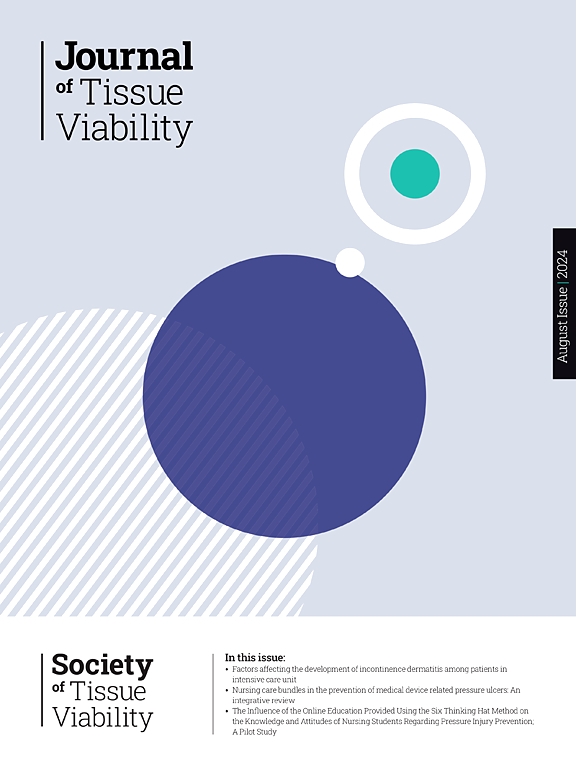三种压疮预防支持面在坐位患者中维持经皮气体张力的能力
IF 2.4
3区 医学
Q2 DERMATOLOGY
引用次数: 0
摘要
目的:本研究评估了三种坐位干预措施——静态泡沫(SF)、交变压力(AP)缓冲垫和侧压(LP)装置——通过维持臀部组织灌注水平来降低坐位个体压疮(PU)风险的有效性。方法8名健康参与者在每次干预中坐下30分钟,然后站立10分钟恢复时间。在右侧坐骨结节处测定经皮组织氧(TcPO2)和二氧化碳(TcPCO2),监测组织灌注。反应被记录为相对于每个参与者卸载的基线气体张力的百分比变化,并分为三个风险级别。统计分析包括配对、单尾t检验,以比较每种座位干预对经皮气体张力的影响。结果与SF缓冲垫相比,AP和LP装置显示出较低的缺血性二氧化碳水平,TcPCO2平均分别增加13.8%±12.0%和14.3%±12.0%,而SF缓冲垫平均增加96.5%±106.5%。AP(- 29.2%±15.7%)和LP(- 28.3%±32.6%)相应的TcPO2下降明显小于SF(- 67.8%±29.0%)。参与者在最低风险类别中使用AP(17.5分钟)和LP(18.2分钟)的时间明显多于使用SF(2.2分钟)的时间。结论与SF相比,AP和LP装置更有效地维持了良好的臀部组织灌注,这表明它们在降低坐位患者PU风险方面具有潜在的益处。这些发现支持需要进一步研究,以确认大样本量和较长持续时间的干预措施的有效性。本文章由计算机程序翻译,如有差异,请以英文原文为准。

The ability of three pressure-ulcer prevention support-surfaces to maintain physiological transcutaneous gas tensions in the seated patient
Aims
This study evaluates the effectiveness of three seating interventions—static foam (SF), alternating pressure (AP) cushion, and lateral pressure (LP) device—in reducing pressure ulcer (PU) risk among seated individuals by maintaining tissue perfusion levels in buttocks tissue.
Methods
Eight healthy participants were seated on each intervention for 30 min, followed by a 10-min standing recovery period. Transcutaneous tissue oxygen (TcPO2) and carbon dioxide (TcPCO2) were measured at the right ischial tuberosity to monitor tissue perfusion. Responses were recorded as a percentage change relative to each participant's unloaded baseline gas tensions and categorised into three levels of risk. Statistical analysis included paired, one-tailed t-tests to compare the impact of each seating intervention on transcutaneous gas tensions.
Results
Both AP and LP devices revealed a lower magnitude of ischemic carbon dioxide compared to the SF cushion, with mean TcPCO2 increases of 13.8 % ± 12.0 % and 14.3 % ± 12.0 %, respectively, versus 96.5 % ± 106.5 % for SF. The corresponding TcPO2 decrease was significantly less for AP (−29.2 % ± 15.7 %) and LP (−28.3 % ± 32.6 %) than for SF (−67.8 % ± 29.0 %). Participants spent significantly more time in the lowest risk category on the AP (17.5 min) and LP (18.2 min) devices than on the SF (2.2 min).
Conclusion
The AP and LP devices maintained favourable buttocks tissue perfusion more effectively compared to the SF, indicating their potential benefit in reducing PU risk for seated patients. These findings support the need for further research to confirm the efficacy of interventions across large sample sizes and longer durations.
求助全文
通过发布文献求助,成功后即可免费获取论文全文。
去求助
来源期刊

Journal of tissue viability
DERMATOLOGY-NURSING
CiteScore
3.80
自引率
16.00%
发文量
110
审稿时长
>12 weeks
期刊介绍:
The Journal of Tissue Viability is the official publication of the Tissue Viability Society and is a quarterly journal concerned with all aspects of the occurrence and treatment of wounds, ulcers and pressure sores including patient care, pain, nutrition, wound healing, research, prevention, mobility, social problems and management.
The Journal particularly encourages papers covering skin and skin wounds but will consider articles that discuss injury in any tissue. Articles that stress the multi-professional nature of tissue viability are especially welcome. We seek to encourage new authors as well as well-established contributors to the field - one aim of the journal is to enable all participants in tissue viability to share information with colleagues.
 求助内容:
求助内容: 应助结果提醒方式:
应助结果提醒方式:


